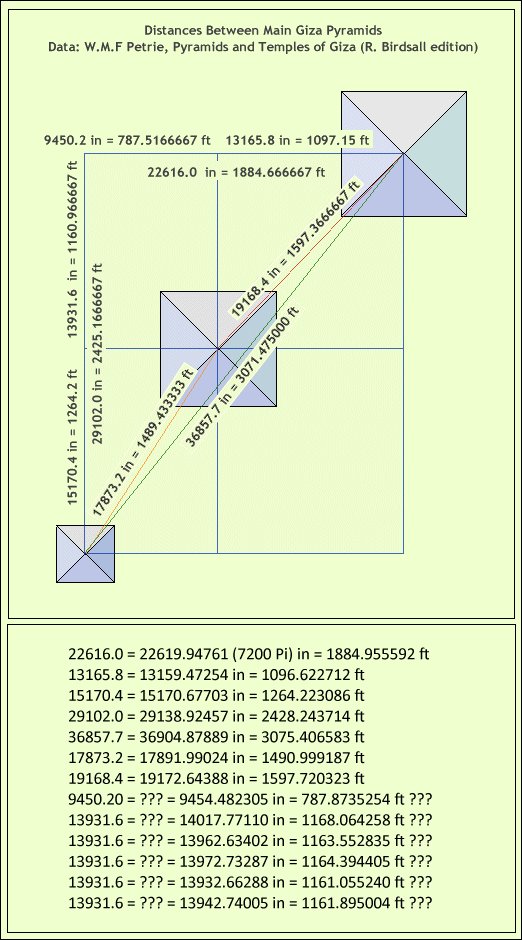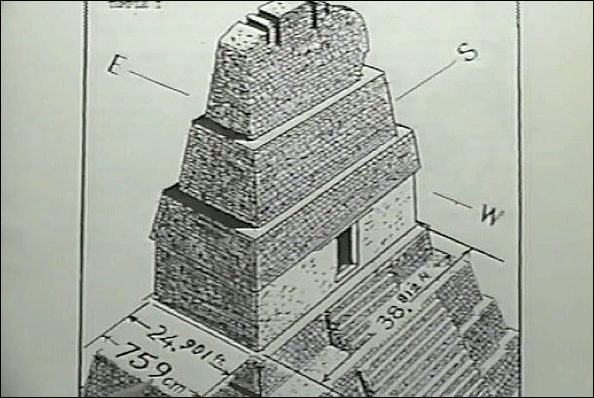Greetings, all
I find my attention drawn toward ancient Egyptian architecture again, for a number of reasons that might sound tangential if I went into full detail, but today started out with the realization that the Harris-Stockdale Unifying Value could perhaps be an oversized variant of the Full Moon Cycle.
The original note that expresses this observation: “It misses a whole number relationship to the Anomalistic Month… roughly, 411.78 / 27.55 = 149.466 whereas 150.00 x 27.55 = 413.25, the HSUV exactly. That’s part of Peter’s formula that’s associated with the distinction of Unifying Value…”
Naturally, this has drawn new attention to the Full Moon Cycle, and I started puttering around and soon noticed what seems like a conspicuous absence of the leading candidate, 411.82022774, in the A Column of the recently posted projections for the Planetary and Lunar Cycle values, in spite of several equations that point to the possibility that it may belong to the A Column and not B or C.

These suggestions include affinities with various for the Jupiter Orbital Period, the Saturn Synodic Period, and the A Column value for the Lunar Calendar Year (the Lunar Calendar Year value placement in the three columns is much less negotiable after what the Chephren Pyramid has taught us about the Lunar Year), and I’m sure there’s more.
I’ve also been glancing at Petrie’s data for the placement of the three big Giza pyramids again – not that it was relevant but Petrie’s data contains a raw measure that is an “Annoyance” for the same reason the “Real Mayan Annoyance” is an “Annoyance” – because it makes us think it’s 2.920160646 x 10^n, but probably can’t be. Having seen at least several equally “Annoying” 293…. figures in the recent table that combines Planetary and Lunar Data to obtain their ratios, I basically needed to go back to Giza and compare “Annoyances”.
 Petrie’s Giza layout data with the “Annoying” 29102.0 inches showing. Many experiments try to point to 29201.60646 ft, but that’s quite a liberty being taken with Petrie’s data, almost 100 inches = ~8.33 ft. Surely other possibilities should be considered before associating an error that great with Petrie’s surveying. 29102.0 inches when converted to feet tends to resemble the reciprocal of the Full Moon Cycle: 29102.0 / 12 = 2425.1666666 ft = 1 / (412.3427943 / 10^n), Full Moon Cycle (textbook value) = 411.78443010 days.
Petrie’s Giza layout data with the “Annoying” 29102.0 inches showing. Many experiments try to point to 29201.60646 ft, but that’s quite a liberty being taken with Petrie’s data, almost 100 inches = ~8.33 ft. Surely other possibilities should be considered before associating an error that great with Petrie’s surveying. 29102.0 inches when converted to feet tends to resemble the reciprocal of the Full Moon Cycle: 29102.0 / 12 = 2425.1666666 ft = 1 / (412.3427943 / 10^n), Full Moon Cycle (textbook value) = 411.78443010 days.
Already thinking of the Full Moon Cycle then, somehow it wasn’t long before I was reminded that the total number of feet directly North and South between the apices of Cheops and Mycerinus’ Pyramid has a history of suggesting the reciprocal of the leading Full Moon Cycle candidate, and soon I found myself falling down a rabbit hole into a strange world of relationships between this candidate and other figures, both established and still struggling to become established…
Then I tried again to work out the length/width ratio for this Great Rectangle that is defined by the locations of the centers of the three biggest pyramids at Giza, and down the rabbit hole, again…
I tried to take a break, went over to GHMB to see what was new, where Siiiiisame had started several threads about possible relationships between the Precessional Cycle (as in the rather impressive book “Hamlet’s Mill”) and 28 mansions from Chinese astrology, and (can you see it coming?) down the very same rabbit hole the third time in only several hours.
I’m still thinking about how best to even try to describe what’s down there… Suffice it that if the total North to South distance between the peaks of Cheops and Chephren’s pyramids really is the reciprocal of the leading Full Moon Cycle candidate, there may be a remarkable number of tie-ins.
Naturally, all this generated considerable curiosity and determination to try to understand more about the mysterious Giza layout plan. Given some of the relationships that prompted the suggestions, there may now be fairly high confidence in all but 2 projections from this model. To illustrate, that means something like this:
 Latest suspicions about the original intended values for Petrie’s data for the main layout of Giza’s pyramids. The estimate for the diagonal looks oversized, but it passes inspection after being reformed from refined length and width for the “Great Giza Rectangle”. (Errors in the length and width may be magnified during the generation of the diagonal).
Latest suspicions about the original intended values for Petrie’s data for the main layout of Giza’s pyramids. The estimate for the diagonal looks oversized, but it passes inspection after being reformed from refined length and width for the “Great Giza Rectangle”. (Errors in the length and width may be magnified during the generation of the diagonal).
In a number of ways, this generally seems to be so self-referential that I’m not sure I’ve seen anything like it since the putatively self-referential formulas that might have been used for rooms in structures at Rio Bec in Mesoamerica, although I don’t know if that trend is quite able to continue to the very end.
One thing that might be noteworthy about all this very curious business is what seems to be considerable conversancy with the width of Tikal Temple I’s temple platform.
 Drawing of Tikal Temple I labelled with data from Teobert Maler, by Our Founder, Carl P. Munck
Drawing of Tikal Temple I labelled with data from Teobert Maler, by Our Founder, Carl P. Munck
Quite a bit has been learned the past few years about the figure 38.81314681 and its significance to astronomy and calendar formulas, but there appears to be still more to the story and I am still aspiring to try to articulate some of it here.
Previously it was suggested that Temple I has a high affinity for the Great Pyramid mathematically, including parallel geodetic functions and utilization of one of our top two Phi-like numbers, 1.618829140, sometimes referred to as “Not-Phi”. The Great Pyramid shows it to us as a close approximation of the natural half base / apothem ratio of any true 2 Pi pyramid. Note that the natural ratio from geometry in this circumstance isn’t Phi either, it’s more like about 1.6189 than the Golden Ratio Phi, 1.618033989.
So how did we climb Temple I in Guatemala and end up down the same rabbit hole as at Giza?
1 / 411.8202774 = 2428.243714 / 10^n; 2428.243714 / 2 = 1214.121857 = “Not A Remen” x 10^n; 2428.243714 x 4 = 9712.974856 = Inner lintel circle diameter of Stonehenge x 100 = 6 x 10^n x Not Phi 1.618829140; 2428.243714 x 8 = 19425.94971 = number of earth hours, minutes, and seconds in the standard Venus Orbital Period of 224.83738008 days: 224.83738008 x 24 h x 60 m x 60 s = 19425949.70 is part of the story…
When we go to look at the length/width ratio of the great Giza Rectangle, length 2428.243714 ft (?), width 1884.955592 (600 Pi) ft,
2428.243714 / 1884.955592 = 1.288246069 = 5 / 3.8813246106, and there the Tikal Temple I number is again.
What has this to do with Chinese astrology and astronomy? Well, if we take the 360* of the sky and try to divide them into “28 mansions”, we get 360 / 28 = 12.85714285. If we match that to 1.288246069, we get the Great Pyramid’s answer to “280 Cubits high”, which is 27.94546572 x 10…
So, the height of the Great Pyramid (from the final pavement) in Royal Cubits OR ten times the height of the missing apex section in Imperial Feet / (360 x 2) = 3.8813246106.
As for the Precession Cycle, for which many alternative researchers including myself may work with 25920 (years) as an experimental approximation, we can obtain the leading candidate for Full Moon Cycle from (1067.439159 / 25920) x 10^n = 411.8202774
So, (1 / 411.8202774) x 10^n = 2428.243714 = (3.8813246106 / 16) x 10^n.
Suffice it to say then that I think Tikal Temple I may know some things about the Full Moon Cycle (as well as many other major solar system objects), and Giza seems to know a lot about it too.
As for the rest of it, perhaps it should wait for a little while. If the last several pieces would fall into place as neatly as the rest of it has been trying to, I will have a completed basic plan of the Giza Layout for the very first time.
Maybe it will take one more very strange day… (besides how very strange it seems that the ancient astronomers still seem to be that far ahead of us somehow, that is).
–Luke Piwalker